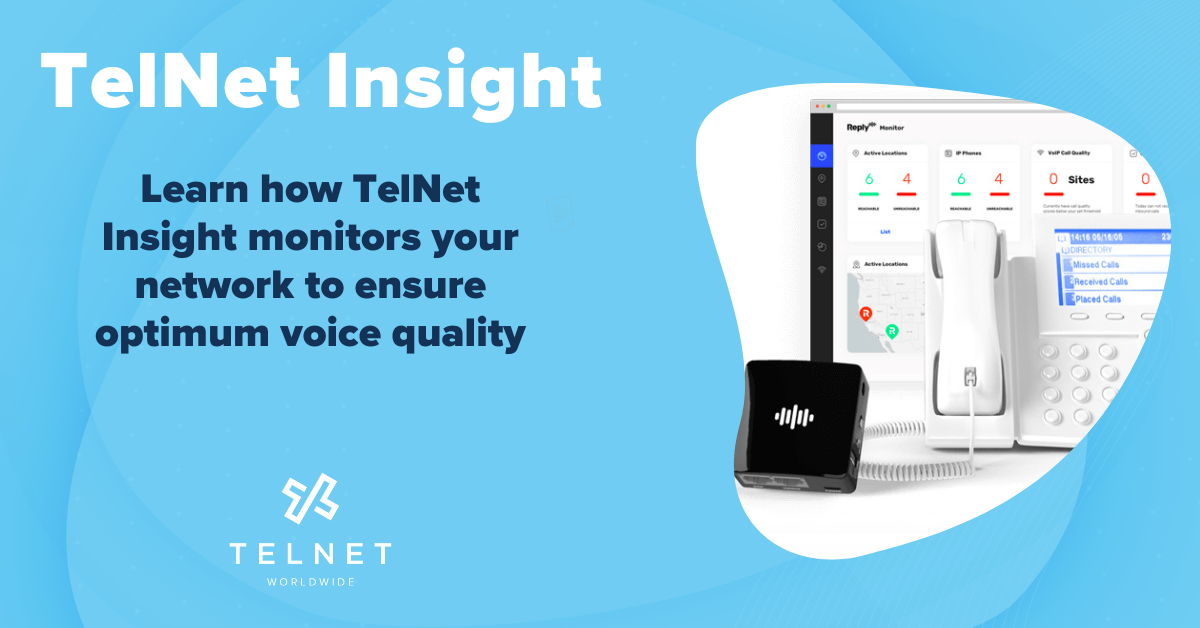If you’re transitioning your phone systems to a Voice Over IP (VoIP) solution, an optimally configured network makes all the difference when it comes to call quality.
In this article, we look at the most important metrics to monitor in order to ensure that your calls sound crystal clear and how TelNet’s newest product, “Insight,” can help.
In this article, we look at:
- Network metrics that provide insight into your VoIP readiness
- What you can do to optimize your network for VoIP
- How TelNet Insight can help
Want to learn more about TelNet Insight and how it can help you? Contact a TelNet networking expert today.
What to Watch on Your Network
Gathering data about your network is the most important thing that you can do to assess your readiness to switch to a VoIP solution – crucial items to keep an eye on are your bandwidth, latency, jitter, and the configuration of your networking equipment.
Bandwidth
Effective bandwidth management is crucial for a smooth VoIP experience. Network congestion can result in buffering and reduced call quality. Optimizing your network for the simultaneous transmission of voice and data is key to preventing congestion issues.
Latency
Latency represents the time it takes for data to travel from the sender to the receiver. High latency can lead to awkward pauses and delays in communication. To minimize latency, optimizing network settings and selecting a reliable service provider are essential. To ensure optimal call quality, it’s important to ensure that latency does not exceed 150ms one-way or 300ms round trip.
Jitter
Related to latency, jitter refers to the variability in the arrival times of data packets. When it comes to VoIP, excessive jitter can result in disruptions and distortions in the transmitted voice. Mitigating jitter involves maintaining a stable network infrastructure to ensure a consistent flow of data packets. Keeping jitter under 30ms is generally accepted as the benchmark for maintaining high call quality.
Network Configuration
The way that your network is designed and your network equipment is configured are the biggest factors in determining your ultimate call quality experience. A few configuration settings to take into consideration are as follows
- Quality of Service (QoS) settings
- SIP ALG configuration
- Firewall configuration
Quality of Service (QoS) Settings. Quality of Service (QoS) plays a pivotal role in prioritizing VoIP traffic over other less time-sensitive data. By implementing QoS settings, you can ensure that voice packets receive preferential treatment, minimizing the risk of lag and ensuring a smoother communication experience.
SIP ALG Configuration. The Session Initiation Protocol Application Layer Gateway (SIP ALG) is a feature designed to facilitate communication between devices and the VoIP server. However, its implementation can sometimes lead to call drops and one-way audio. TelNet Worldwide generally recommends disabling SIP ALG.
Firewall Configuration. In order for your users to utilize TelNet Worldwide’s services it’s important that your network permits communication between hosts on your network and TelNet’s voice infrastructure. If this isn’t the case it’s more than likely that your newly acquired VoIP solution will not function optimally. For a full list of IP addresses and ports that communication must be allowed on, you should check out TelNet’s LAN requirements documentation on our Resources page.
It’s a Lot to Monitor. TelNet Insight Can Help.
Moving to a voice over IP solution requires understanding, monitoring, and maintaining the capabilities of your network. With Insight deployed on your network, you’ll be able to monitor key metrics for voice quality and identify any problems.
If you’re interested in ensuring that call quality on your networks is as good as possible, contact a TelNet sales representative today and ask about Insight!






